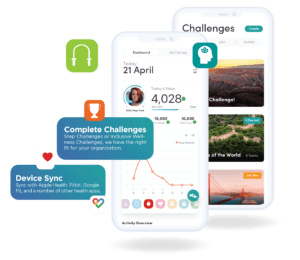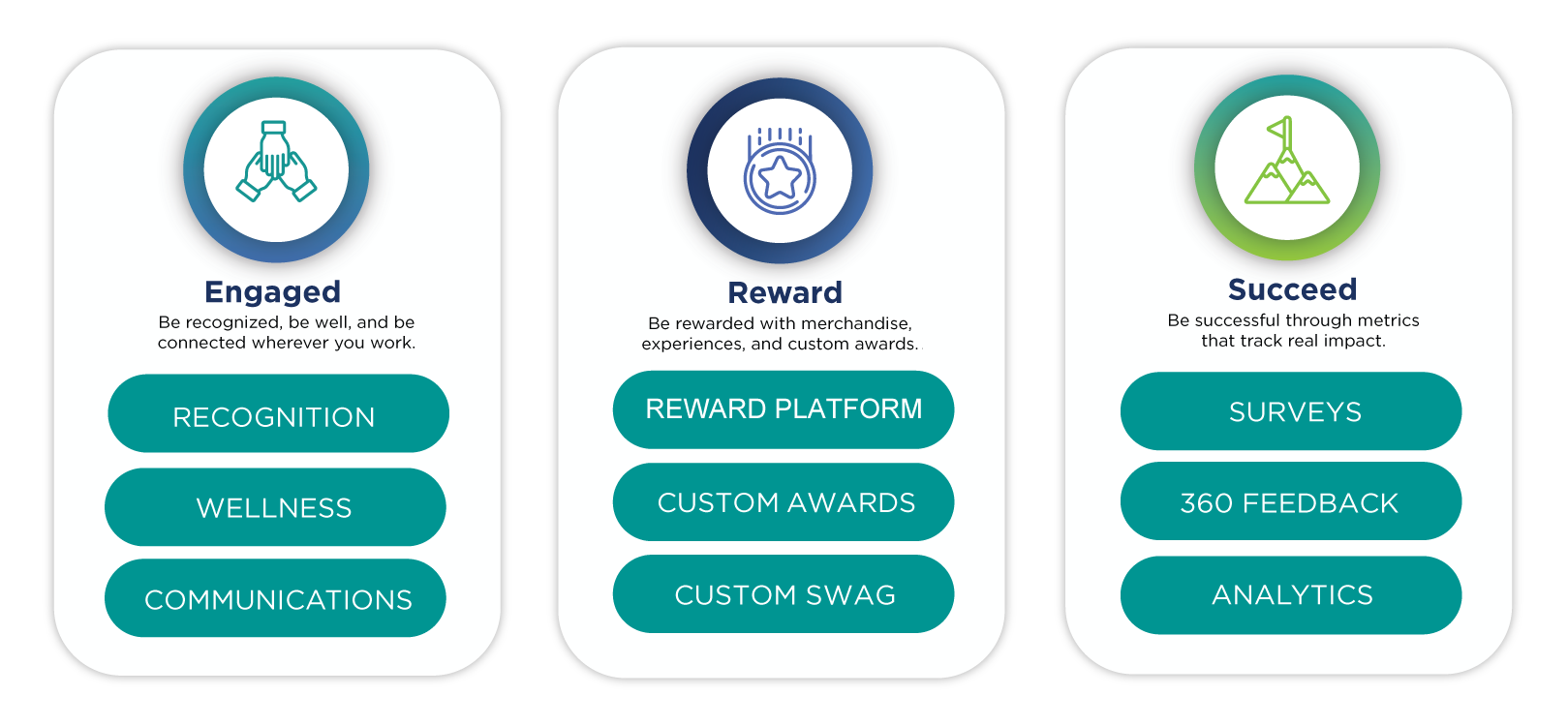October 30, 2023


Employee wellbeing initiatives are about more than just health benefits and vacation days. It's a holistic approach to monitoring and improving your employees' mental, physical, and emotional health.
Your employees are more than just cogs in a machine—they're humans with aspirations, challenges, fears, and emotions. And in an age where they spend the majority of their waking lives working at your business, shouldn't those hours be filled with more than just tasks, deadlines, and to-do lists?
Employee wellbeing initiatives aim to make the workplace more than people in chairs and numbers on spreadsheets. It drives employees toward personal development, fulfillment, growth, and genuine happiness.
And, fortunately, that's not just good for humanity—it's also good for your bottom line. More engaged employees lead to better business outcomes:
- 24% less turnover
- 10% higher customer ratings
- 21% higher profitability
- 17% higher productivity
Thanks to well-publicized statistics on the benefits of employee engagement (like these, these, and these), you probably don't need to be convinced it's important. However, knowing and implementing are two very different challenges.
That's why we put this guide to employee wellbeing initiatives together.
It'll guide you through various initiatives to consider, expanding across multiple elements of employee wellbeing to help you create a comprehensive program that covers your teams on all fronts. We'll also show you a handful of tips and best practices to effectively implement these initiatives and get the most bang for your buck.
First, let's cover a few basics to make sure we're on the same page.
What Are Employee Wellbeing Initiatives?
Employee wellbeing initiatives are strategic actions, programs, or policies you introduce to support your workforce's health, happiness, and satisfaction. These initiatives recognize that employees are more than assets—they're complex individuals with physical, social, and psychological needs.
Addressing these needs helps you create a more engaged, productive, and loyal workforce. It also improves the lives and wellbeing of your employees, making the world a better place, one person at a time.
Elements of Employee Wellbeing
Humans are intricate. Every individual faces unique obstacles, and there's never a one-size-fits-all solution to solving everyone's problems. Here are a few elements of employee wellbeing to keep in mind as you develop your initiatives program:
- Physical: Initiatives that focus on maintaining and improving employees' bodily health through exercise, nutrition, and regular health check-ups.
- Mental: Programs that support cognitive health and stress management, providing resources for mental health challenges.
- Social: Activities that foster interpersonal relationships, team cohesion, and a sense of belonging within the workplace.
- Emotional: Efforts that address employees' feelings, helping them manage emotions and build resilience.
- Financial: Resources and guidance to assist employees in managing their finances, planning for the future, and achieving financial stability.
- Professional: Opportunities that promote career growth, skill development, and continuous learning within the organization.
- Personal: Initiatives supporting employees' individual interests, hobbies, and personal growth outside their professional roles.
- Work-Life Balance: Policies and practices that ensure employees have a harmonious balance between their work responsibilities and personal life.


RELATED: Promoting Employee Wellbeing in the Workplace: 6 Strategies for a Thriving Work Environment
Do Employee Wellbeing Initiatives Make an Impact?
While it's hard to argue that employees face a complicated list of struggles (inside and outside the workplace), the concern sometimes comes down to the solutions.
Do employee wellbeing initiatives actually alleviate employee problems? Does the return justify the investment?
Let's look at a few studies and statistics to better evaluate the impact of these programs:
- For every dollar invested in employee wellness, medical expenses decrease by $3.27, and absenteeism reduces by $2.73, yielding a 6-to-1 ROI.
- Wellness initiatives boost productivity, adding 10.3 work hours annually per employee and saving an average of $350 per employee due to fewer sick days.
- A high-engagement culture predicts a lower likelihood of new occurrences of depression and anxiety.
- Thriving employees are 32% less likely to be watching for or actively seeking another job
- 63% of U.S. workers say having a greater work-life balance and better personal wellbeing is very important when considering whether to take a job with a different organization.
- Employees who strongly agree that their employer cares about their overall wellbeing are 36% more likely to thrive overall, 71% less likely to report experiencing a lot of burnout, and 3x more likely to be engaged at work.


27+ Employee Wellbeing Initiatives
Modern workplaces are shifting the focus from simple productivity to holistic employee wellbeing. A happy, engaged, and healthy workforce is the backbone of any successful organization, and many are investing to support their teams.
However, it's not easy knowing where to start.
You've probably heard of everything from ping-pong tables to week-long retreats in Mexico to company-branded buses. With so many options, it's hard to avoid paralysis by analysis.
First, you'll need to figure out what your employees need. If everyone already has a gym membership and healthy habits, you probably don't need to invest too much in this area. Yet, if employees feel mentally disconnected or unengaged, you might want to focus on mental and social initiatives.
RELATED: How to Support Your Staff with Employee Mental Health Programs


Use regular employee surveys and feedback systems to gauge your employees' status. These insights will help you create and tailor your wellbeing initiatives program. Once you know the issues, you can start to explore the potential solutions.
Below, we've broken out initiative ideas into the following areas:
- Physical health
- Mental health
- Social and community
- Financial wellbeing
- Professional and personal development
- Work-life balance
Experiment with these programs and craft the perfect all-encompassing employee wellness program.


Physical Health Initiatives
Today's sedentary work culture often puts physical health in the backseat, leading to health issues and decreased productivity. Physical health initiatives aim to counteract this by integrating health-conscious habits into employees' daily routines.
Work and physical health shouldn't be unrelated. Just as a football player's diet impacts their performance on the field, your employees' habits hurt or help their performance in the office. Prioritizing better health leads to improved wellbeing for your staff and a more energetic, focused, and resilient workforce.
1. In-House Fitness Centers or Gym Memberships
Provide access to physical exercise facilities. If there's no on-site fitness center, consider giving your employees local gym memberships. This helps encourage employees to participate in regular exercise, helping employees maintain fitness, reduce stress, and boost energy levels. A fit employee is less likely to suffer from common ailments, leading to reduced absenteeism and increased productivity.


2. Walking Meetings
Transform traditional sit-down sessions into walking meetings. For example, if your managers have weekly one-on-one meetings with employees, consider encouraging these meetings to take place outside.
Another option is to invest in walking treadmills. Some businesses will put these in communal areas, allowing managers and direct reports to catch up while still keeping their laptops or notes handy and accessible.


3. Healthy Snack Bars
Stock your office pantry with nutritious snacks like fruits, nuts, and whole grains. Providing your employees with healthy snacks makes choosing nutritious food options easier during work hours. This can reduce the consumption of junk food, stabilize energy levels, and improve overall health.
When you eat well, you usually feel well. Instead of just investing in a hodge-podge of snacks, survey your employees and see what they want. They might be more drawn to protein bars or smoothies instead of bananas and whole-grain muffins.


4. Biometric Screenings
Organize regular health screenings for employees to assess vital metrics like blood pressure, cholesterol, and glucose levels. Most employees likely care about these insights, but they'll rarely take personal time away from work to make it happen.
Instead of encouraging employees to take a regular health check-up, bring the screening to them. Biometric screenings provide early detection of potential overall health issues, allowing for timely interventions. They also raise health awareness among employees, encouraging them to adopt healthier lifestyles.
5. Health and Wellness Challenges
Initiate challenges like step-count contests, healthy recipe competitions, or fitness milestones. These challenges foster a sense of community and friendly competition among employees. They motivate individuals to adopt healthier habits and celebrate achievements, often leading to long-term positive lifestyle changes.
Need help getting started? Partner with our fitness solution, Walker Tracker. It can help you implement, schedule, and monitor all of your health challenges and milestones, gamifying the experience and helping you boost employee wellness.


Mental Health Initiatives
Burnout, stress, and mental health challenges are rising, but these can be addressed and alleviated with intentional action. Mental health initiatives create an environment where employees feel safe, understood, valued, and empowered to seek help when they need it.
6. Mindfulness and Meditation Sessions
Organize sessions that introduce and practice mindfulness and meditation techniques. These sessions promote mental calmness, enhance focus, and help employees manage daily stresses. Regular practice can lead to improved emotional regulation, better decision-making, and increased overall wellbeing.
While the individual sessions themselves will help employees, they'll also train them on additional self-care techniques they can practice on their own. This can support and empower employees to recognize stress and combat it proactively.
RELATED: Terryberry Acquires Innovative Employee Mental Health App to Prioritize Employee Well-being

7. Access to Counseling Services
Provide employees with free or subsidized access to professional mental health counseling. Counseling offers a safe space for employees to discuss challenges, seek guidance, and develop coping strategies. This proactive approach can prevent minor issues from escalating and ensures employees have the support they need.
8. Mental Health Day
Allow employees the flexibility to take days off specifically dedicated to mental health. Poor mental health days can strike as unexpectedly as the flu—so why shouldn't employees be free to treat the symptoms similarly?
Mental health days give employees a break to recharge, seek treatment, or simply rest. Recognizing the importance of mental health days can reduce burnout and improve employee wellbeing.
9. Stress Management Workshops
Conduct workshops that provide tools and strategies to handle stress effectively. Employers can foster a more resilient workforce by equipping employees with stress-reducing techniques. These workshops can lead to better productivity, reduced absenteeism, and a more positive work environment.
They also acknowledge that stress is natural and felt, empowering employees to have more open and transparent conversations with their co-workers and managers. Employees shouldn't be afraid to bring up stress and burnout with their team. These proactive conversations can help employees identify and employ coping mechanisms and solutions rather than simply searching for a new job (where they're likely to experience similar feelings).


RELATED: Diversity Culture: How to Bring Psychological Safety to the Workplace
10. Quiet Zones
Designate specific areas in the workplace free from noise and distractions. Quiet zones offer employees a space to focus, reflect, or simply take a mental break. Such spaces can enhance productivity and provide relief from the constant hustle of the workplace.
If you have a remote workforce, consider adding quiet time periods to the calendar. This might be every day at the same time, or it might be something like no-meeting Fridays.
11. Employee Feedback Platforms
Create platforms or channels where employees can voice their concerns, provide feedback, or make suggestions. Feedback platforms ensure that employees feel heard and valued. They provide insights into potential workplace challenges and allow for timely interventions, fostering a culture of open communication and trust.
While you can make time for formal feedback sessions annually, quarterly, or even more often, we recommend using tools that provide a space for employees to provide ongoing feedback. Don't make your workforce wait three months to praise another employee, celebrate an implementation, or voice a complaint—give them the tools they need to do it in the moment.


Social and Community Initiatives
Social and community initiatives aim to build stronger interpersonal relationships, promote a sense of unity, and connect employees to the broader community. Building these social bonds helps create a more cohesive, engaged, and motivated workforce.
12. Team-Building Activities
Organize various events, games, and activities designed to strengthen team dynamics. Team-building activities enhance collaboration, improve communication, and foster a sense of camaraderie among employees. These activities can lead to a more harmonious work environment and improved project outcomes.
It also can help employees make friends and become closer with those they work with. Since most of their waking hours are spent with these people, it can be a massive social and mental boost to build substantial relationships.


13. Volunteer Opportunities
Offer opportunities for employees to engage in community service or charitable activities. Volunteering strengthens team bonds and connects employees to the larger community. It instills a sense of purpose, boosts morale, and enhances the company's image as a socially responsible entity.
14. Social Gatherings
Host regular events, outings, or gatherings where employees can socialize and relax. Social gatherings provide a break from the routine, allowing employees to connect on a personal level. These events can boost morale, reduce stress, and foster a sense of belonging within the organization.


15. Inclusion Initiatives
Implement programs and policies that celebrate diversity and promote an inclusive work environment. Inclusion initiatives ensure that every employee feels valued and respected regardless of background. A diverse and inclusive workplace can lead to more creativity, broader perspectives, and improved problem-solving.
Financial Wellbeing Initiatives
Financial stress is one of the leading causes of anxiety and distraction in the workplace. Addressing the economic wellbeing of employees helps you alleviate some of these pressures, leading to a more focused, satisfied, and productive workforce.
Financial wellbeing initiatives equip employees with the tools and know-how they need to make informed financial decisions, ensuring stability both now and in the future.
16. Financial Planning Workshops
Conduct workshops that cover essential topics like budgeting, investing, and overall financial planning. These workshops empower employees with the knowledge to manage their finances effectively. By understanding how to budget and invest, employees can work towards financial stability, reducing stress and distractions related to monetary concerns.


17. Retirement Planning
Offer resources, seminars, or one-on-one sessions that guide employees in planning for their retirement. Retirement planning ensures that employees are prepared for their future, alleviating concerns about financial security in their later years. Providing this support shows your long-term commitment to your employees' wellbeing.
18. Salary Advance Options
Establish policies that permit employees to access a portion of their salary ahead of the regular payday in case of emergencies. Salary advance options provide a safety net for employees facing unexpected financial challenges. This initiative can prevent employees from resorting to high-interest loans, reducing financial stress and promoting loyalty to the company.
Setting and explaining these policies upfront helps your employees know their options. They'll know what they can ask for without putting the business or human resource employees under any sort of burden.
Personal and Professional Development
These initiatives ensure your employees are equipped to face current challenges and prepared for future opportunities while feeling valued and supported.


19. Continuous Learning Opportunities
Offer a range of courses, workshops, and seminars tailored to enhance specific skills or broaden knowledge bases. Survey your employees to see what programs they might want to learn about.
Continuous learning keeps your employees updated with the latest industry trends, tools, and methodologies. This boosts their confidence and competence and ensures your company remains competitive and innovative.
20. Career Coaching
Provide employees with access to career counselors or coaches who can guide them in their professional journey. Career coaching helps employees set clear career goals, identify growth opportunities, and navigate challenges. This guidance can lead to higher job satisfaction, better performance, and a more straightforward path to advancement.


21. Recognition Programs
Implement programs regularly acknowledging and rewarding outstanding employee contributions, achievements, and milestones. Recognizing and celebrating achievements boosts morale, motivation, and loyalty. Employees who feel valued are likelier to be engaged, productive, and committed to the organization's success.
Want to take a comprehensive approach to your recognition program? Get started with Terryberry. We provide an all-in-one employee recognition program designed to show appreciation for all your team members, whether in-office, at home, or around the globe.
22. Mentorship Programs
Establish platforms where experienced professionals can share their knowledge, insights, and guidance with less experienced colleagues. Mentorship fosters a culture of continuous learning, collaboration, and support. It accelerates professional growth, bridges knowledge gaps, and strengthens interdepartmental relationships.


Work-Life Balance Initiatives
Striking a balance between work and personal life is more challenging than ever, especially with flexible work-from-home policies and our always-on (and connected) devices. However, it's not productive or healthy for employees to experience long-term imbalances.
They need to adopt a healthy work-life balance that gives them the time, flexibility, and encouragement to recharge and take care of personal needs.
23. Flexible Work Schedules
Allow employees to customize their work hours based on their personal needs and preferences. Flexible schedules cater to individual needs, from early risers to those with family commitments. This flexibility can lead to increased job satisfaction, reduced stress, and higher productivity as employees work during their most productive hours.


24. Remote Working Options
Provide opportunities for employees to work from locations other than the office, such as home or co-working spaces. Remote work offers employees a change of environment, reduces commute stress, and provides more personal time. This flexibility can boost morale, reduce burnout, and even lead to increased productivity.
25. Unlimited Vacation Policies
Implement policies that allow employees to take time off as they see fit without a set limit on vacation days. Unlimited vacation policies trust employees to manage their time responsibly. This trust can lead to increased job satisfaction, reduced burnout, and a stronger sense of loyalty to the company.
26. Parental Leave
Offer generous parental leave policies for mothers and fathers, ensuring they have adequate time to bond with their new child. Comprehensive parental leave supports families during crucial times, reduces stress, and ensures employees can return to work fully focused and recharged.


27. Creative Breaks
Designate times or spaces where employees can engage in non-work-related activities, such as reading, drawing, or even meditating. Creative breaks offer a mental respite, allowing employees to recharge and return to tasks with a fresh perspective. Such breaks can foster creativity, reduce stress, and improve job satisfaction.
Tips and Best Practices for Implementing Initiatives at Your Company
Brainstorming ideas for employee wellbeing initiatives is an excellent place to start, but sometimes implementation can be the most challenging part of the process. Everything from personal preferences and logistics to budgets and time constraints will impact how you roll out these programs.
Here are a few tips and best practices to help you get started with these initiatives with as little friction as possible:


- Assess Employee Needs: Before introducing any initiative, conduct surveys or focus groups to understand your employees' specific needs and preferences. Tailoring initiatives based on actual feedback guarantees higher employee engagement and success rates.
- Start Small and Scale: Begin with a few key initiatives, monitor their success, and then expand based on feedback and results. This phased approach allows for adjustments and ensures resources are used effectively.
- Promote Awareness: Make sure all employees are aware of the available initiatives. Use internal communication channels, such as newsletters, intranet, or town hall meetings, to promote and explain the benefits of each program.
- Ensure Accessibility: Make all initiatives accessible to everyone, regardless of their role, location, or schedule. For instance, if offering workshops, consider recording them for those who can't attend in real time.
- Regularly Review and Update: The needs of employees change over time. Review the effectiveness of initiatives periodically, gather feedback, and make necessary adjustments to keep them relevant and beneficial.
- Lead by Example: Senior management and leadership should actively participate in and promote employee wellbeing initiatives. When employees see leaders valuing these programs, they are more likely to engage.
- Offer Variety: Different employees have different needs. Offer a variety of initiatives that cater to diverse preferences, from fitness challenges to mental health resources.
- Maintain Confidentiality: Keep employees' participation and any shared information confidential for mental wellness or personal development initiatives.
- Celebrate Successes: Recognize and celebrate when employees achieve milestones or the company sees positive results from the initiatives. This can boost morale and encourage further participation.
- Seek External Partnerships: Consider partnering with external organizations or experts to bring in specialized knowledge or resources. This can enhance the quality and variety of the initiatives offered.
- Allocate Adequate Resources: Allocate a dedicated budget and build a team responsible for implementing and managing these initiatives. This shows employees that the company is genuinely invested in their wellbeing.
Common Obstacles (and Solutions) to Change
While we can't predict every challenge you might face, we've done our best to cover a variety of issues (and solutions) we typically see with initiative implementation:


1. Lack of Awareness or Interest:
- Problem: Employees might not be aware of the initiatives or might not see their value.
- Solution: Launch comprehensive communication campaigns, host informational sessions, and involve influencers or champions within the company to promote and explain the benefits of the initiatives.
2. Budget Constraints:
- Problem: Limited resources might hinder the introduction of comprehensive wellbeing programs.
- Solution: Start with low-cost initiatives, seek partnerships with local businesses or organizations, and focus on demonstrating the ROI of wellbeing programs to secure more funding in the future.

3. Cultural Resistance:
- Problem: Existing company culture might resist new initiatives, especially if they require significant changes in behavior or mindset.
- Solution: Engage leadership to champion the initiatives, offer training sessions, and gradually introduce changes to allow the company culture to adapt.
4. Logistical Challenges:
- Problem: Implementing certain initiatives, especially those requiring physical resources or spaces, might pose logistical issues.
- Solution: Consider virtual or outsourced alternatives, re-purpose existing spaces, or collaborate with nearby businesses or facilities.
5. Concerns about Confidentiality:
- Problem: Due to confidentiality concerns, employees might be hesitant to participate in initiatives, especially those related to mental health.
- Solution: Ensure strict confidentiality protocols, use third-party providers when necessary, and communicate these measures clearly to employees.

6. Difficulty in Measuring Impact:
- Problem: Companies might struggle to quantify the benefits and impact of wellbeing initiatives.
- Solution: Implement regular feedback mechanisms, conduct surveys, and use key performance indicators (KPIs) to measure aspects like employee engagement, productivity, and absenteeism.
7. One-Size-Fits-All Approach:
- Problem: Initiatives might not cater to the diverse needs of all employees.
- Solution: Offer a variety of programs, seek regular feedback, and be willing to adapt or introduce new initiatives based on employee needs and preferences.
8. Time Constraints:
- Problem: Employees might feel they lack time to participate in wellbeing activities during work hours.
- Solution: Integrate wellbeing activities into the workday, offer flexible scheduling, or provide resources employees can access in their own time.

9. Lack of Expertise:
- Problem: Your company might not have the internal expertise to implement specific initiatives.
- Solution: Partner with external organizations, hire consultants, or provide training to existing staff to fill knowledge gaps.
10. Short-Term Focus:
- Problem: Companies might expect immediate results and discontinue initiatives if they don't see instant benefits.
- Solution: Set realistic expectations, focus on long-term benefits, and understand that the actual value of wellbeing initiatives often manifests over time.
Terryberry's Comprehensive Platform: A One-Stop Solution for Employee Wellbeing
While you'll want to take a personalized approach to your employee wellbeing initiatives, it's best to choose a holistic partner that can adapt to your evolving needs. Our platform stands out by offering a comprehensive suite of solutions catering to various facets of employee wellbeing.
From engagement to recognition and rewards to impactful analytics, Terryberry gives your business the tools to foster a thriving and engaged workforce.


Engage: Fostering Recognition and Employee Wellness
Engagement is the cornerstone of a motivated and productive workforce. Terryberry's platform emphasizes the importance of keeping employees engaged through various means:
- Recognition Programs: Terryberry's recognition programs are designed to acknowledge and celebrate the achievements and milestones of employees.
- Wellness Initiatives: Our employee wellness programs offer resources, challenges, and incentives to keep employees healthy and motivated.
- Effective Communication Strategies: We emphasize the importance of clear, consistent, and positive communication to keep everyone aligned, informed, and valued.
Reward: Appreciating Employee Contributions
Recognizing and rewarding employees for their contributions is a surefire way to boost morale and loyalty:
- Reward Platforms: Terryberry's platforms offer options for employers to reward their staff, from merchandise to experiences, ensuring there's something special for everyone.
- Custom Awards and Swag: Personalization adds a touch of sincerity to rewards. Our custom awards and swag options empower your company to offer unique tokens of appreciation that resonate with your brand and values.
Succeed: Ensuring Impactful Results through Analytics
Terryberry's platform provides the tools to monitor the effectiveness of your employee wellbeing initiatives and keep progress moving in the right direction:
- Surveys and 360 Feedback: Gathering feedback is essential for growth. Terryberry's tools, like surveys and 360 feedback, provide invaluable insights into employee sentiments, needs, and areas of improvement.
- Metrics and Data for Continuous Improvement: Beyond feedback, Terryberry's analytical tools dive deep into metrics and data, offering a clear picture of the effectiveness of initiatives and highlighting areas for enhancement.

Make Employee Wellbeing a Priority
Your employees are more than just assets—they're the heart and soul of your business. Without them, your company and its mission wouldn't be possible.
Show them the appreciation and commitment they deserve by prioritizing employee wellbeing at your company. This can help foster a positive and productive work environment where people want to show up and put in their time and effort.
However, committing to employee wellbeing initiatives and actually making them happen are two different things.
Fortunately, we're here to help you put your plans into motion.
Don't leave the wellbeing of your employees to chance. Partner with Terryberry to provide your workforce with the holistic wellbeing solutions they need to start thriving. Schedule a demo with our team to learn how Terryberry can transform your work environment forever.


